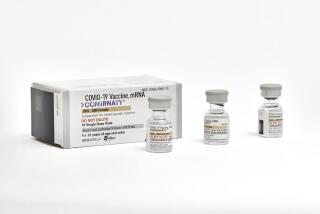Rise and Fall of Heart Disease Rate Under Scrutiny
- Share via
It is one of public health’s most revered articles of faith: Heart disease in the United States rose in epidemic fashion from the turn of the century until the 1960s, but with public awareness and improved treatment, it then started a long, unrelenting decline.
Between 1965 and 1978, government and private statistical analyses have concluded, the rate dropped by 26.5%.
But as will happen--often--in medicine, a new study dismisses the assertions that there was ever an epidemic rise in heart disease and that death rates have lately tumbled. Instead, a New Zealand expert suggests each impression is a statistical mirage created by faulty or inconsistent diagnoses on death certificates and other vagaries of U.S. and international data-gathering.
W. E. Stehbens of the Wellington School of Medicine says, in an essay published in the journal Lancet, that statistics-gathering--and figures derived from death-certificates, in particular--is suspect. He is far from the first to make the allegation that death certificate diagnoses are subject to vagaries and vacillations, ranging from ineptitude and honest error by doctors to diagnostic fads. The new broadside, though, said a spokesman for the American Heart Assn., may represent the first time a reputable observer has used these traditional reservations to cast doubts on what have become established beliefs about heart disease.
Reviewing dozens of studies of heart disease death rates dating to the turn of the century, Stehbens concludes flatly that “the degree of inaccuracy of vital statistics . . . is of such uncertain magnitude that . . . the concept of an epidemic rise and decline of (coronary heart disease) must be regarded as unproven and governmental or health policies based on unreliable data become untenable.”
AIDS Military Statistics in Doubt
In the growing fear that AIDS may be moving into the population at large--from its base among homosexuals and intravenous drug users--studies are cited often purporting to show that AIDS among military personnel has broken out into the community of non-drug using heterosexuals.
But public health officials in Colorado warn that scrutiny of AIDS characteristics among service personnel reveals that life-style information gathered by military doctors is probably massively inaccurate. In a detailed review of 29 cases, officials in Colorado Springs found sexual preference and drug use habits to which military personnel admitted to civilian doctors was nearly the inverse of what was told to military physicians.
Dr. John Muth, of the El Paso County Health Department, said he and his colleagues interviewed U.S. Army and Air Force personnel over a two-year period and found that, overall, while armed service doctors believed only 23% of the AIDS patients were homosexual or intravenous drug users, the true proportion was 86%--or roughly equal to what has been observed in civilian populations so far. The area of Colorado where Muth’s department is located takes in the Air Force Academy, the Army’s Ft. Carson and three air bases.
Some of Muth’s data were published last week in the Journal of the American Medical Assn. Taking issue with Army doctors who previously concluded that military AIDS had an apparently different sociology than the civilian form, Muth said in a telephone interview that military statistics “are almost certainly wrong.”
Muth said finding that military personnel are not truthful about possibly AIDS-related social conduct is hardly surprising, given the pressures of the chain of command combined with factors that would hinder candidness about such matters in any employment setting. “This showed us what we thought we knew,” Muth said. “What we were seeing was a population that didn’t differ at all from general population.”
Aspirin and Weight
Aspirin--a drug that shows a remarkable ability to be found effective in an ever-growing variety of uses--is being touted as having a possible role in weight loss. A combination of aspirin and the allergy relief drug ephedrine is suspected to have at least a theoretical ability to abet weight reduction.
This speculation is based on one study in which mice were found to increase their metabolic rates when fed the two drugs. Increasing metabolic rate as a means to reduce weight is undergoing a resurgence of interest, according to researchers at Harvard Medical School and the University of London, who published their aspirin-ephedrine findings in the American Journal of Clinical Nutrition.
Mixtures of aspirin and ephedrine, the researchers speculated, “could be put to new use in treatment of human obesity. They (active ingredients in aspirin and ephedrine) may be presumed to be relatively safe if only because they have been part of traditional medicine for centuries.”
Kids and Car Seats
Young children should continue to be placed in car safety seats for as long as they will fit in them--not just until they turn 4--and vehicle and child seat makers must search for additional ways to make automobiles crash-safe for youngsters, Orange County researchers have urged.
The recommendations were made based on a study of children injured in crashes who were taken to nine Orange County emergency centers. The research was conducted by a team at the UC Irvine Medical Center. Dr. Phyllis Agran said she concluded that manufacturers must develop better seat belt and safety seat designs to protect children until they are 10 because their bodies are still too small to be adequately restrained by seat belts designed for adults. Her findings were published in the Journal of Trauma.
Producing better so-called “booster” seats, which raise the child into position in an adult belt, and changing the designs of seat belts are also necessary, she said--possibly to include adjustable anchor points at which belts can be secured to car bodies so children’s pelvises are supported instead of having the belt ride up onto their abdomens. Such riding up can cause severe injury in a crash.
Brian O’Neill, director of the Washington-based Insurance Institute for Highway Safety, said the cautions are appropriate. “There’s always been a concern about the geometry of adult belts” when they are used on children, he said. Agran and O’Neill said use of cushions or booster seats to support children older than 4 is essential.
Risks of Polio Vaccine
It’s more a commentary on how a debilitating disease has been conquered, but a new study of the few new cases of polio that now occur in the United States concludes that 76% of them are caused by adverse reactions of polio immunization. But if that makes you think for a moment about skipping polio vaccine for your children, say researchers at the federal government’s Centers for Disease Control, remember that in the mid-1950s, an average of 16,000 people a year were paralyzed by the disease.
In stark contrast, the research team observes in a study published in the Journal of the American Medical Assn., the national total of polio cases from 1973 to 1984 was 138. But even the small risk should be cause for concern, the researchers say, noting that their findings conclude that the chance of having an adverse reaction to polio vaccine is greater on the first dose than for subsequent doses in immunization schedules. For first doses, there was an average of one case of polio for each 520,000 administrations. For subsequent doses, the risk dropped to one case per 12.3 million doses.
Despite the relative rarity of immunization-induced polio, concluded the research team, vaccine scientists should be concerned with determining why the first dose seems comparatively more risky than subsequent doses.






